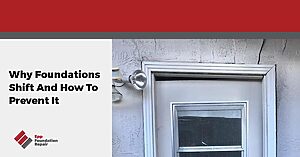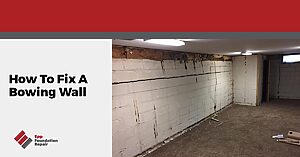SETTLING HOME?
Foundation Settling
Foundation settlement occurs when a house begins sinking downward. It is caused by the soil below a home being unstable, causing it to expand and contract, resulting in this sinking movement, or settling, of the house’s foundation. This leads to cracks in interior and exterior surfaces, most often on the foundation or on walls and ceilings.
Foundation settling is an issue that happens with most homes and is one of the biggest threats to any structure, especially when not dealt with appropriately or in a timely manner.
Main Causes Of Foundation Settlement
- Evaporation: Hot and dry conditions can cause soil to pull away from the foundation as moisture is drawn out. Settlement due to this moisture imbalance can cause cracks to appear throughout the structure, weakening its structural integrity.
- Transpiration: Tree roots can dehydrate the soil beneath a home causing soil shrinkage similar to evaporation and to similar effect.
- Plumbing Leaks: Water from leaky plumbing is often a major contributor to foundation and settlement problems including heaving, which occurs when the ground beneath your home begins to rise and push up due to the pressures.
- Drainage: Improper drainage will lead to excess moisture buildup, which can erode or consolidate soils. Excessive moisture may cause heaving and expansive soils.
- Site Preparation: Cut and fill situations, where the soil is removed from part of the building site and stacked on another, need proper soil stabilization before a structure is built. Loose, unstable soil can cause unexpected movements of the ground beneath the foundation.
Signs of Foundation Settlement
Common signs of foundation settlement include, but aren’t limited to, the following:
- Uneven floors
- Cracks in wall, floors, and ceilings
- Stair step cracks in brick or masonry
- Diagonal cracks from the corners of doors and windows
- Bowed foundation walls
- Chimneys or porches that are leaning away from the house
- Floors and ceilings that are no longer in contact with the wall
- Moldings that are separating from the wall or ceiling
- Torn or wrinkled wallpaper (The wall behind the wallpaper might be cracked.)
Foundation Settling FAQS
How serious is foundation settling?
All foundations will settle into the soil slightly after they’re built. This usually isn’t a problem as long as the settlement is uniform. That is, when all sections of the foundation are settling into the soil at the same rate. Problems develop when the foundation is settling into the soil unevenly. This is called differential settlement. Differential settlement is serious and can cause severe structural damage.

When should I worry about foundation settling?
You should worry when your foundation is experiencing differential settlement. Differential settlement will worsen if it isn’t stopped and will eventually lead to severe structural damage. Therefore, you’ll save money on repair costs by catching the problem early.
How can I prevent my home’s foundation from settling?
Since most foundation problems are caused by excess moisture in the ground around the foundation, you can go a long way toward preventing foundation issues by getting groundwater around the foundation under control. Some ways to do that include the following:
- If necessary, regrade your yard so that it slopes away from the foundation. This will prevent water from draining toward the foundation.
- Use downspout extensions to channel water away from the foundation before being released.
- Don’t plant water-hungry flowers and shrubs next to the foundation.
- Install a drain tile system.
How much foundation settling is OK?
No amount of differential settlement is OK. Even a slight amount of differential settlement puts tremendous stress on a foundation and can lead to severe structural damage. If it isn’t corrected, the problem will worsen and you’ll end up paying more for the repair.
How many years does it take for a house to settle?
As we noted above, all structures will settle into the soil slightly after they’re built. This process usually takes 1-2 years. So long as the settlement is uniform, there shouldn’t be anything to worry about. The problem is differential settlement.




